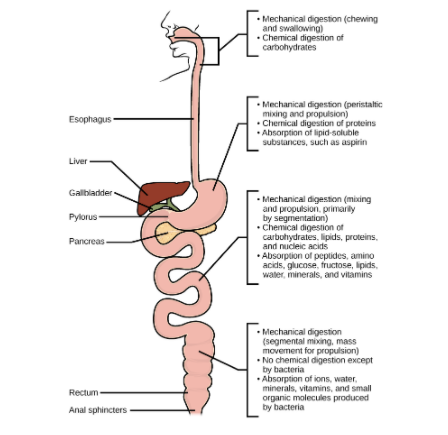
What is peristalsis? How does it help in digestion?
Answer
494.4k+ views
Hint:It usually occurs in oesophagus also known as food pipe. It helps to push food forward.
Peristalsis is a series of wave-like contractions of the muscles that are involved in the food movement and in the movement of other liquid particles in the digestive tract to various processing organs that are located in the digestive.

Complete answer:
Involuntary movements of the longitudinal and circular muscles, primarily in the digestive tract but occasionally in other hollow tubes of the body, that occur in progressive wavelike contractions. Peristaltic waves occur in the oesophagus, stomach, and intestines.
Smooth muscles contract behind the bolus to prevent it from being squeezed back into the mouth. Then rhythmic, unidirectional waves of contractions work to rapidly force the food into the stomach. The migrating motor complex (MMC) helps trigger peristaltic waves.
It helps in pushing food forward by rhythmically contracting oesophagus.
The strong wave-like motions of the smooth muscle in the oesophagus carry the food to the stomach, where it is churned into a liquid mixture called chyme. So, digestion becomes easy as food is converted into simpler form due to peristalsis the food gets broken down into simpler forms.
When chyme passes from the stomach into the small intestine, peristaltic waves shift it back and forth and mix it with digestive enzymes and fluids.
Note: Food like almond and almond milk can increase peristalsis for good digestion. So, people should take these kinds of food so that food can be better digested.
Peristalsis is a series of wave-like contractions of the muscles that are involved in the food movement and in the movement of other liquid particles in the digestive tract to various processing organs that are located in the digestive.

Complete answer:
Involuntary movements of the longitudinal and circular muscles, primarily in the digestive tract but occasionally in other hollow tubes of the body, that occur in progressive wavelike contractions. Peristaltic waves occur in the oesophagus, stomach, and intestines.
Smooth muscles contract behind the bolus to prevent it from being squeezed back into the mouth. Then rhythmic, unidirectional waves of contractions work to rapidly force the food into the stomach. The migrating motor complex (MMC) helps trigger peristaltic waves.
It helps in pushing food forward by rhythmically contracting oesophagus.
The strong wave-like motions of the smooth muscle in the oesophagus carry the food to the stomach, where it is churned into a liquid mixture called chyme. So, digestion becomes easy as food is converted into simpler form due to peristalsis the food gets broken down into simpler forms.
When chyme passes from the stomach into the small intestine, peristaltic waves shift it back and forth and mix it with digestive enzymes and fluids.
Note: Food like almond and almond milk can increase peristalsis for good digestion. So, people should take these kinds of food so that food can be better digested.
Recently Updated Pages
The correct geometry and hybridization for XeF4 are class 11 chemistry CBSE

Water softening by Clarks process uses ACalcium bicarbonate class 11 chemistry CBSE

With reference to graphite and diamond which of the class 11 chemistry CBSE

A certain household has consumed 250 units of energy class 11 physics CBSE

The lightest metal known is A beryllium B lithium C class 11 chemistry CBSE

What is the formula mass of the iodine molecule class 11 chemistry CBSE

Trending doubts
What is the modal class for the following table given class 11 maths CBSE

Give an example of a solid solution in which the solute class 11 chemistry CBSE

Describe the effects of the Second World War class 11 social science CBSE

Which of the following methods is suitable for preventing class 11 chemistry CBSE

Number of oneone functions from A to B where nA 4 and class 11 maths CBSE

What organs are located on the left side of your body class 11 biology CBSE




